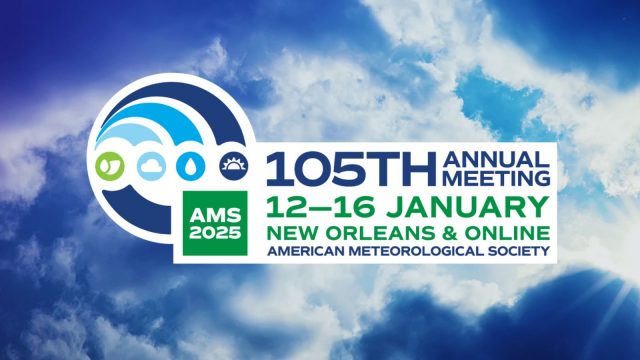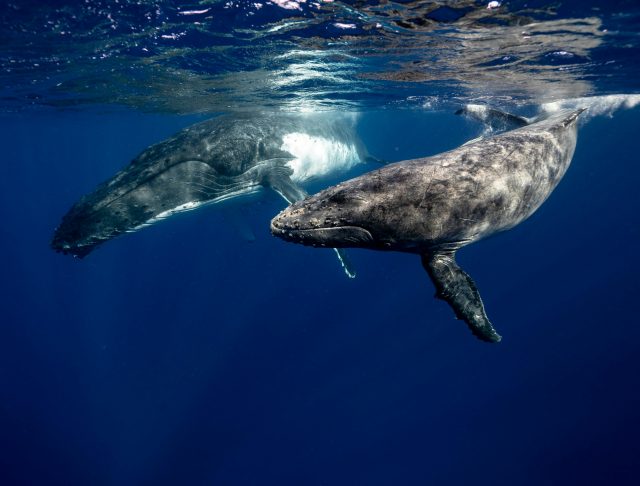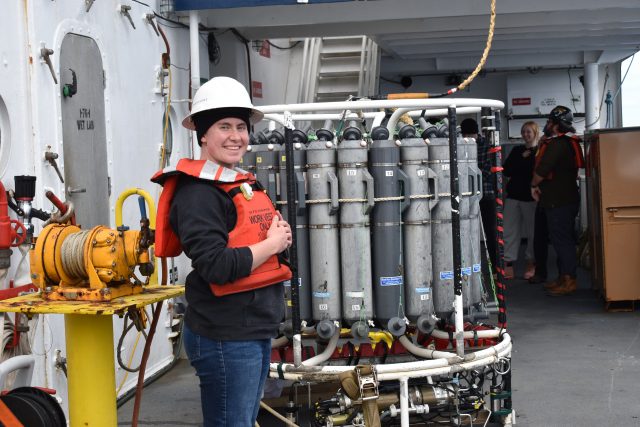News
Exploring Air-Sea Interactions at the AMS Annual Meeting
The Annual Meeting of the American Meteorological Society (AMS) is the largest national gathering for atmospheric scientists, drawing experts from various disciplines, including oceanography. This event serves as a key venue for advancing research and fostering collaborations across scientific communities.
AMS plays a critical role in disseminating oceanographic research through several journals, including the Bulletin of the AMS, Journal of Climate, Journal of Atmospheric and Oceanic Technology, and Journal of Physical Oceanography. These publications provide valuable platforms for cutting-edge studies in meteorology and oceanography.
A long-standing proponent of air-sea interaction research, the AMS supports this field through its dedicated Committee on Air-Sea Interaction. This committee organizes biennial research conferences at the annual meeting and frequently collaborates with other AMS committees to host joint sessions at these locations. Most recently, the Air-Sea Interaction Committee has expanded its collaborative efforts beyond AMS, partnering with the American Geophysical Union (AGU) to organize sessions at the Ocean Sciences Meeting.
At this year’s AMS Annual Meeting, the 24th Conference on Air-Sea Interaction was held in New Orleans, providing a platform for researchers to present their latest findings. James Edson, Principal Investigator of the Ocean Observatories Initiative (OOI), and Ben Barr, Postdoctoral Investigator at Woods Hole Oceanographic Institution (WHOI), along with their colleagues gave two presentations investigating air-sea interaction in high winds and extreme environments using OOI data. Their talks included:
- 10.2 Edson and Barr: Improvements to the COARE Bulk Flux Algorithm under Extreme Wind and Wave Conditions using NSF OOI Data
- 10.5 Barr, Seo, Edson, Sauvage, and Clayson: Understanding and Constraining Interfacial and Sea Spray Heat Fluxes in High Winds Using Direct Covariance Heat Flux Observations
These presentations were met with significant enthusiasm, sparking in-depth discussions that extended well into the lunch break. The engagement and interest generated by these talks reflect the growing importance of high-quality observational data in advancing our understanding of air-sea interactions, particularly under extreme environmental conditions.
As research on air-sea interactions advances, events like the AMS Annual Meeting play a crucial role in driving progress in marine meteorology. By leveraging innovative observational tools and fostering interdisciplinary collaboration, scientists are set to make significant strides in understanding the complex dynamics at the interface of the ocean and atmosphere.
Read More2025 OOIFB Summer School on Acoustics: Applications Now Open
The Ocean Observatories Initiative Facility Board (OOIFB), funded by the U.S. National Science Foundation (NSF), is hosting the 2025 Summer School on Acoustics from July 14–18, 2025, at the University of Washington in Seattle, WA.
This five-day, in-person program will provide targeted lectures, hands-on tutorials, and practical exercises using real-world examples and NSF Ocean Observatories Initiative (OOI) data products. Participants will focus on accessing, analyzing, and interpreting acoustic data alongside complementary oceanographic datasets available through OOI.
By the end of the program, participants will have a deeper understanding of underwater sound propagation, passive and active acoustic instruments (e.g., hydrophones and echosounders) deployed through OOI, and the available datasets. They will also learn how to navigate OOI data portals, apply basic acoustic data processing methods, and explore how these data can support scientific research. The program also offers opportunities to connect with a professional network of researchers using OOI data.
There are no registration fees, and travel support is available for participants from U.S. institutions. For details on program requirements, eligibility, a draft agenda, and the application process, visit the OOIFB Summer School on Acoustics webpage.
Please share this opportunity with your colleagues and networks. For questions, contact Holly Morin (holly@ooifb.org).
Read MoreIrminger Sea Convection and the roles of Atmospheric Forcing and Stratification
The high-latitude North Atlantic, is a region where seasonal convection results in deep water formation, a process critical to the Atlantic Meridional Overturning Circulation (AMOC). Surface cooling by cold air and strong winds in the Irminger Sea transforms the surface water and drives deep convection in winter. Prior studies have shown that AMOC strength is linked to the extent of water mass transformation in the Irminger Sea and Iceland Basin. A study by de Jong et al. (2025) used a 19-year time series with weekly resolution compiled from moorings and Argo floats to evaluate the year-to-year variability of deep convection and its relationship to atmospheric forcing versus water column stratification.
A time series of surface forcing for the 19-year analysis period (2002-2020) was obtained from the European Center for Medium-range Weather Forecasting (ECMWF) ERA-5 global atmospheric reanalysis. Hydrographic data from the near-surface to 2500 m was collected from three sources: the NIOZ Long-term Ocean Circulation Observations (LOCO) mooring, the GEOMAR Central Irminger Sea (CIS) mooring, and the OOI Hybrid Profiler Mooring (HYPM). Surface temperature and salinity from Argo, ERA-5, and the OOI surface mooring, along with nearby Argo profiles, were used to provide data at the surface and in the upper water column. The records were merged with 25 m vertical resolution and one week time resolution. Mixed layer depth was determined from the hydrographic profiles using a published algorithm with further quality control using multiple criteria.
The time series of potential vorticity (PV) and mixed layer depth (MLD; Fig. 1d), highlights the significant interannual variability. Some years (e.g. 2002-2003) show relatively shallow winter MLD and little evidence of sustained low PV (which would indicate deep mixing) between years. Other years (e.g. 2015-2016) show strong convection, deep MLD, and sustained low PV. While the change in stratification due to warming and freshening related to climate change is expected to weaken convection future convection, analysis showed that in this record there was a strong correlation between the annual maximum MLD and the total accumulated winter heat loss. The correlation between maximum summer stratification and maximum MLD the following winter was not significant. Thus, among other findings, the authors concluded that during the period analyzed atmospheric forcing is three times more important than pre-existing stratification in determining the maximum winter mixed layer depth in the Irminger Sea.
The processed and edited temperature and salinity profiles from the OOI Irminger Sea HYPM from September 2014 to May 2020 are described by Le Bas (2023). The processed data are publicly available from the NOAA National Centers for Environmental Information (NCEI) and referenced with a DOI. The NCEI record includes information about data quality control, validation and drift correction, gridding method, and algorithms for computation of data products.
This project shows the potential for long-duration OOI moored profiler records to be combined with other data sources to provide unique insights into interannual variability of mixing and deep convection in the Irminger Sea. It is notable that the authors undertook a significant data quality control effort and took advantage of the OOI shipboard validation CTD casts (along with non-OOI CTD data sources) in their processing.
[caption id="attachment_35691" align="alignnone" width="624"] Figure 29: Time series of the combined LOCO, CIS, OOI and Argo record from 2002-2020. a) temperature, b) salinity, c) potential density and d) potential vorticity with mixed layer depth overlaid (black dots). From de Jong et al., 2025.[/caption]
Figure 29: Time series of the combined LOCO, CIS, OOI and Argo record from 2002-2020. a) temperature, b) salinity, c) potential density and d) potential vorticity with mixed layer depth overlaid (black dots). From de Jong et al., 2025.[/caption]
___________________
References:
De Jong, M.F, K.E Fogaren, L. LeBras, L. McRaven and H. Palevsky, (2025). Atmospheric forcing dominates the interannual variability of convection strength in the Irminger Sea. J. Geophys. Res., 130, e2023JC020799. https://doi.org/10.1029/2023JC020799.
Le Bras, I. (2023). Water temperature and salinity profiles from the Ocean Observatories Initiative Global Irminger Sea Array Apex profiler mooring from September 2014 to May 2020 (NCEI Accession 0285241). NOAA National Centers for Environmental Information. Dataset. https://doi.org/10.25921/wzvr-fk49.
Read MoreBloom Compression Alongside Marine Heatwaves Contemporary with the Oregon Upwelling Season
Black et al. (2024) examine the impacts of marine heatwave (MHW) events on upwelling-driven blooms off the Oregon coast. They combine OOI data from Endurance moorings off Oregon with satellite data and indices of upwelling and MHW presence to determine how MHW’s impact these blooms. Their work focuses on MHWs and coincident events that occurred off Oregon during the summers of 2015–2023. They found the presence of MHW’s limited the offshore extent of phytoplankton blooms. In late summer 2015 and 2019, both documented MHW years, coastal phytoplankton biomass extended on average 6 and 9 km offshore of the shelf break along the Newport Hydrographic Line, respectively. During years not influenced by anomalous warming, coastal biomass extended over 34 km offshore of the shelf break. Reduced biomass also occurs with reduced upwelling transport and nutrient flux during these anomalous warm periods. However, the enhanced front associated with a MHW aids in the compression of phytoplankton closer to shore. Over shorter events, heatwaves propagating far inshore also coincide with reduced chlorophyll a and sea-surface density at select cross-shelf locations, further supporting a physical displacement mechanism. Paired with the physiological impacts on communities, heatwave-reinforced physical confinement of blooms over the inner-shelf may have a measurable effect on the gravitational flux and alongshore transport of particulate organic carbon. Black is a PhD student at Oregon State University and notes that all data used in the paper, including of course OOI data, are open source. They provide details regarding data access methods and intermediate processing steps along with code modules to reproduce the work at https://github.com/IanTBlack/oregon-shelf-mhw.
Black et al. focus much of their analysis on the Oregon Offshore mooring, CE04 (Fig. x). Here they show individual warm events aligned with periods where Chl a was much lower than the time-series average and the climatological mean. The analysis period for 2019 had the lowest average Chl a across all years. From the CE04-derived Chl a climatology, they observed an occurrence of a regular spring bloom (April) and a summer bloom (September). The peak of the summer bloom appears contemporary with the warmest time of year at CE04, and years 2019 and 2023 were the only years that experienced MHWs during this same period. The summer blooms of 2019 and 2023 at CE04 were also noticeably suppressed and difficult to differentiate from surrounding Chl a values.
[caption id="attachment_35688" align="alignnone" width="624"] Figure 28: Ocean Observatories Initiative (OOI) CE04, Coastal Upwelling Transport Index (CUTI), and Biologically Effective Upwelling Transport Index (BEUTI) time series between 2015 and 2023. Daily mean values are in light blue. Red vertical spans indicate potential marine heatwave (MHW) events and gray vertical spans indicate the time between the spring and fall transition dates. A centered 11-d rolling mean was applied to smooth the data (black).[/caption]
Figure 28: Ocean Observatories Initiative (OOI) CE04, Coastal Upwelling Transport Index (CUTI), and Biologically Effective Upwelling Transport Index (BEUTI) time series between 2015 and 2023. Daily mean values are in light blue. Red vertical spans indicate potential marine heatwave (MHW) events and gray vertical spans indicate the time between the spring and fall transition dates. A centered 11-d rolling mean was applied to smooth the data (black).[/caption]
___________________
Reference:
I Black, IT, Kavanaugh, MT, Reimers, CE. “Bloom compression alongside marine heatwaves contemporary with the Oregon upwelling season.” Limnology and Oceanography, no. (2024): First published: 16 December 2024, https://doi.org/10.1002/lno.12757
Read MoreBringing Computer VISION into the Classroom Utilizing RCA Imagery and the OOI Jupyter Hub
There is a rapidly growing demand in Earth system science for workforce expertise in machine learning. To increase marine science students understanding of, and ability to use, artificial intelligence tools, Dr. Katie Bigham and School of Oceanography undergraduate student Atticus Carter are teaching an undergraduate class focused on applying “computer vision” (processing imagery with the computer) to marine science problems. The Computer Vision Across Marine Sciences prototype course for UW undergraduates in the Ocean Technology program includes the development of a Jupyter Binder (a notebook collecting multiple Jupyter Notebooks). Currently, an enormous amount of time is required to manually process imagery collected in marine environments, resulting in a major bottleneck for all research utilizing marine imagery. In this course, students gain an understanding of computer vision capabilities, model training and evaluation, and research applications. The course utilizes real-world datasets from the OOI Regional Cabled Array (RCA), including imagery from remotely operated vehicles utilized on RCA cruises and fixed camera imagery on the array, and from other systems, exposing students to diverse marine habitats. For their final projects, students will develop bespoke models utilizing datasets of their choosing, including RCA imagery. Students can employ the OOI Jupyter Hub for additional computational power, facilitating easy access to imagery and necessary resources. In collaboration with a faculty member in the UW School of Education quantitative data are collected on student learning and feedback for course improvement. The open-access course text is actively under development and is accessible at OceanCV.org. The team aims to improve the materials based on student feedback. Carter will present findings and learnings from the first version of the class at ASLO 2025 Aquatic Sciences Meeting in the Building Data Literacy Skills in the Next Generation of Aquatic Scientists session hosted by OOI Data Labs.
[caption id="attachment_35685" align="alignnone" width="640"] Figure 27: Introductory page for Computer Vision Across Marine Sciences Jupyter Binder and example of artificial intelligence-based predictions of animals in imagery collected by the Regional Cabled Array digital still camera at Southern Hydrate Ridge. This work is supported by an NSF OCE Postdoctoral Research Fellowship to Dr. K. Bigham, University of Washington.[/caption]
Read More
Figure 27: Introductory page for Computer Vision Across Marine Sciences Jupyter Binder and example of artificial intelligence-based predictions of animals in imagery collected by the Regional Cabled Array digital still camera at Southern Hydrate Ridge. This work is supported by an NSF OCE Postdoctoral Research Fellowship to Dr. K. Bigham, University of Washington.[/caption]
Read More Exploring the Coastal Surface Piercing Profiler (CSPP): Capabilities, Challenges & Impact
The Coastal Surface Piercing Profiler (CSPP) is an important component of the Ocean Observatories Initiative (OOI), uniquely designed to collect high-resolution data from the ocean’s surface to the seafloor over the Oregon Shelf. Importantly, as the name implies, the CSPP does not stop at the ocean surface but some of its sensors actually pierces the interface into the near surface atmosphere. Operating in a highly dynamic environment, the CSPP provides valuable datasets that enhance our understanding of ocean-atmosphere interactions, nearshore processes, and biological activity in the upper water column.
In this interview, Jon Fram, co-PI and Program Manager for the Endurance Array (EA), explores the technical capabilities of the CSPP, the difficulties of operating in dynamic coastal conditions, and the significance of its unique datasets. With its ability to profile up through the air-sea interface and its collection of advanced sensors, the CSPP bridges critical gaps in ocean observation. Jon discusses the practical realities of deploying and maintaining the profiler, including a notable recovery effort that illustrates the complexity of coastal oceanographic work.
How does the CSPP operate in such a dynamic environment, and what are some of the challenges associated with deploying and maintaining it?
In between profiles, CSPPs park near the seafloor where currents from waves and tides are relatively calm. As CSPPs winch themselves up to the air-sea interface, they measure winchline tension and they alter their profiling speed to keep the tension constant. This behavior enables CSPPs to surface when waves are up to 3 meters high without the winchline over-wrapping or experiencing snap loads. We monitor conditions so CSPPs don’t profile when seas are too rough. Most of a CSPP’s battery energy goes to operating its winch, so CSPPs need to be recovered/redeployed every 2-3 months and they are limited to 2-4 profiler per day during each deployment (when conditions are sufficiently calm).
What types of sensors and instruments are on the profiler, and what specific data do they collect?
CSPPs average 25 cm/s as they profile upwards. Their CTDs sample at 16 Hz, which corresponds to a measurement every 1.5 cm. Their ~1 Hz instruments include dissolved oxygen (DOSTA), point velocity (VELPT), nitrate (NUTNR), spectral irradiance (SPKIR), photosynthetically active radiation (PARAD), and chlorophyll-a—optical backscatter—CDOM (FLORT). The CSPP is a particularly useful platform for the optical attenuation and absorption instrument (OPTAA), which can be used to characterize phytoplankton communities at the top of the water column.
What are the unique capabilities of the CSPP, and how do its datasets differ from those collected by other platforms within the OOI?
The CSPP is OOI’s only profiler that samples up to the air-sea interface.
How has the profiler contributed to understanding the relationship between atmospheric and oceanic processes in the area?
So far, OOI’s CSPPs have been used to fill in time gaps in mooring data and to fill in spatial gaps between mooring near-surface (NSIF) and benthic (MFN) data. Inshore and shelf CSPP data have been used together to calculate cross-shore exchange of nitrate, which is increased each spring due to coastal upwelling. CSPPs measure at the air-sea surface, so their measurements could be used to validate satellite data.
How could the near-time data transmission from the profiler benefit research efforts or inform stakeholders such as fisheries, conservation groups, or local communities?
Datasets are available within a week after each deployment. They can telemeter all data when they are on the surface at the top of each profile, however, we transfer only data needed for operational decisions to reduce the chance of winchline fouling.
Can you share an anecdote about a particularly challenging or rewarding moment during the deployment, maintenance, or operation of the profiler?
One challenging moment occurred 06 April 2019. During a storm, rough seas (~7m significant wave height, >1 m/s currents) dislodged our 25m depth Oregon Inshore CSPP and deposited it 75 nm north on a pocket beach in Ecola State Park. We climbed down to it, pulled it above the high tide line, disassembled it, and packed it out piece-by-piece up a steep trail in pouring rain. The Endurance Array inshore CSPP and adjacent surface mooring measure the northward fresh/turbid surface current that hugs the Pacific Northwest coast during winter, and which strengthens during storms. This is one example of how the CSPP data can be used to improve our wind, wave and current forecast models.
[caption id="attachment_35671" align="alignnone" width="640"]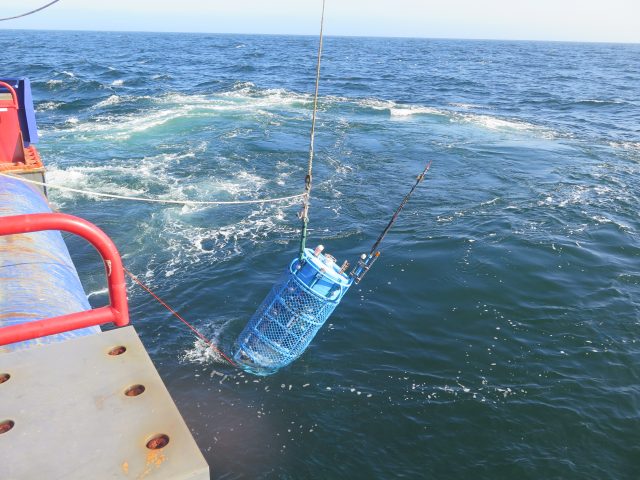 Deployment of CSPP. (c) Jon Fram[/caption]
[caption id="attachment_35670" align="alignnone" width="640"]
Deployment of CSPP. (c) Jon Fram[/caption]
[caption id="attachment_35670" align="alignnone" width="640"]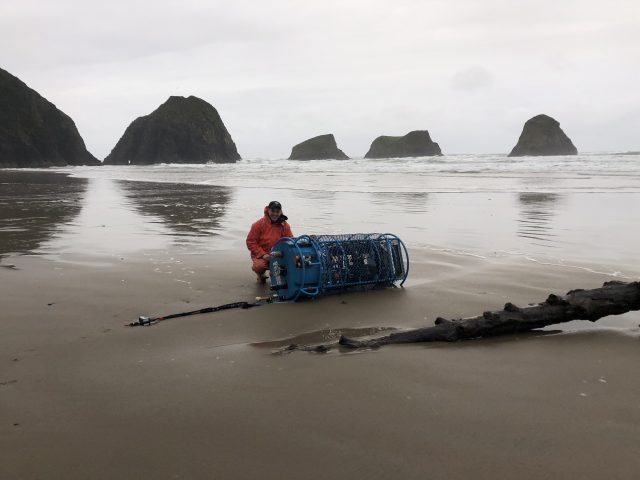 Beach recovery effort. Pictured: Ian Black, OSU. (c): Jon Fram[/caption]
Read More
Beach recovery effort. Pictured: Ian Black, OSU. (c): Jon Fram[/caption]
Read More Processing an Ocean of Data: OOI Insights from the NSF CI Compass Workshop
At the NSF CI Compass virtual workshop, “Data Management: From Instrument to First Storage,” Jeff Glatstein, OOI Senior Manager of Cyberinfrastructure at WHOI, shared key insights into the challenges and advancements in handling large-scale ocean data.
OOI manages enormous data volumes: 175 billion rows of numerical data, 2.8 petabytes of raw data, 13,000 hours of video, and over 2 million digital stills. In the last quarter alone, 36 terabytes of data were delivered to researchers, highlighting the complexity of managing continuous, multi-source data streams.
Jeff introduced the Jupiter Hub environment, which allows researchers to download and process data directly while supporting FAIR metadata standards. He also addressed challenges like storage costs, technical debt, and the need for scalable infrastructure as data demands grow.
Recent upgrades, including Cassandra improvements and enhanced monitoring systems, have improved efficiency. Future efforts focus on GPU use for AI applications, building a third-generation data center, and ensuring cybersecurity and disaster recovery with geographically distributed storage.
Jeff emphasized the importance of collaboration between observatories and the standardization of data formats to improve integration and sharing. His presentation highlighted the ongoing work required to make ocean data accessible, secure, and valuable for research.
The workshop highlighted the critical role facilities like OOI play in advancing ocean science, offering the tools and infrastructure necessary to manage complex data and foster collaboration across the research community.
To learn more about OOI’s data management strategies, check out Jeff Glatstein’s full slide deck from the NSF Workshop. View it here.
[caption id="attachment_35610" align="alignnone" width="640"] (c): Jeffrey Glatstein[/caption]
[caption id="attachment_35607" align="alignnone" width="640"]
(c): Jeffrey Glatstein[/caption]
[caption id="attachment_35607" align="alignnone" width="640"] (c): Jeffrey Glatstein[/caption]
Read More
(c): Jeffrey Glatstein[/caption]
Read More Cyber Resiliency in Ocean Data Systems
With 2.8 petabytes of data collected—and 20-25 terabytes added monthly—the Ocean Observatories Initiative (OOI) is committed to ensuring secure, accessible, and reliable oceanic research data for decades to come. At the Cyber Resiliency Summit 2025, Craig Risien, CI Systems Project Manager at the OOI at Oregon State University, shared insights with theCUBE on how the OOI is addressing long-term data challenges through innovative strategies and collaborative partnerships.
Watch the interview: www.youtube.com/watch?v=5c-a0dTSF-Y&t=748s
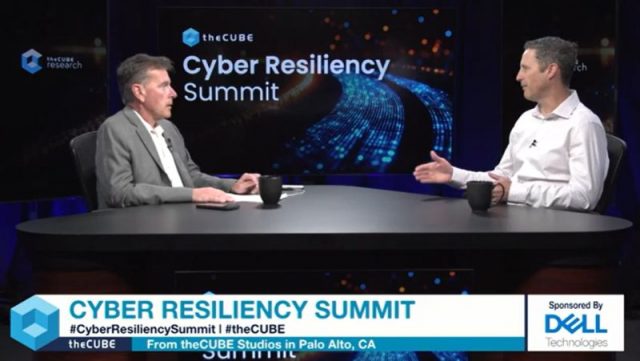
Regional Cabled Array: Monitoring Axial Seamount in Real Time
The Regional Cabled Array (RCA) is the world’s most extensive undersea volcano monitoring system, located off the Oregon coast. Operated by the University of Washington as part of the Ocean Observatories Initiative (OOI), the RCA features a network of submarine cables extending 200 miles offshore from Pacific City and Newport. This system monitors the Axial Seamount, a submarine volcano expected to erupt this year.
In a recent interview, Deb Kelley, OOI Principal Investigator and Director at the University of Washington School of Oceanography, discussed how the RCA collects near-time data to track seismic activity, hydrothermal systems, and chemical changes associated with volcanic activity. The RCA’s data supports long-term research on ocean dynamics and tectonic processes, providing critical insights into the Earth’s underwater systems.
Watch the full interview with KPTV FOX 12 here: https://www.youtube.com/watch?v=PUJMTdka8KI
[caption id="attachment_35589" align="alignnone" width="640"]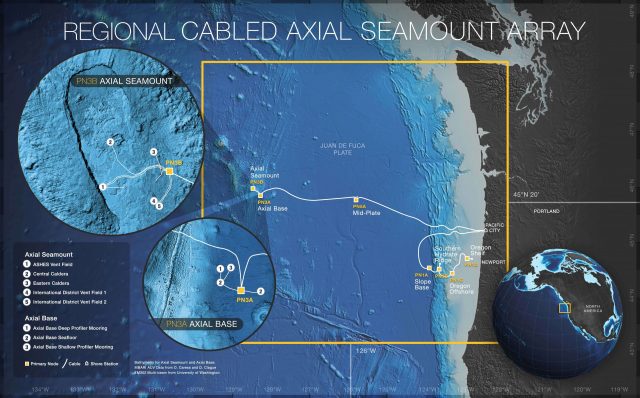 Credit: Center for Environmental Visualization, University of Washington[/caption]
Read More
Credit: Center for Environmental Visualization, University of Washington[/caption]
Read More Life at Sea: Student Reflections from the VISIONS’24 (Leg 3) Expedition
As part of the Regional Cabled Array operations and maintenance 2024 cruise, a cohort of 24 undergraduates spanning different countries of origin, states, and socio-economic backgrounds, participated in the expedition as part of the UW at-sea experiential learning program called VISIONS. This program has allowed over 200 undergraduate students, studying myriad disciplines, the opportunity to spend 8-45 days at sea on NSF-funded global class research ships utilizing state-of-the art remotely operated vehicles (ROV). Onboard, they stand 4-hr on, 8-hr off watches in the ROV control room working alongside the pilots, and RCA engineers and scientists. They work out on deck, learn about ship operations, and gain skills in oceanographic sampling and analyses of fluids. They see first-hand life forms rarely seen thriving in some of the most biologically productive waters in the ocean along the Cascadia Margin, the abyss at 2900 m water depth, and on 350°C underwater hot springs at the summit of Axial Seamount – the most active underwater volcano off the Oregon coast. The interviews below provide a glimpse of VISIONS’24 student impressions of life at sea and their experiences onboard. For many, their lives are forever changed.
Among the 2024 cohort was Morrigan Havely, whose curiosity and eagerness to explore marine science drove them to join the VISIONS program. Their journey aboard the R/V Atlantis highlights the combination of technical skill-building and personal development that the program supports. Morrigan’s experience reflects the unique community and collaborative spirit found at sea, where learning extends beyond science to include teamwork, resilience, and adaptability.
What motivated you to join the VISIONS program?
An oceanography undergraduate praised his experience with the program the year prior and highly recommended I join. One of my biggest goals with becoming a marine science major was to travel, and after reading about the amazing experiences of past students via their blogs, I knew that I wanted to sail aboard the R/V Atlantis.
What skills did you develop or strengthen during your time at sea that you feel will be valuable in your future career?
Time at sea in general is a super valuable experience, because it’s an entirely different culture than on land. You learn to work with people in extremely close quarters at all hours of the day, even if that means getting up at two in the morning to log Jason events. Learning about ship culture and having an on-board experience was an integral part of VISIONS ‘24.
How do you see the skills and experiences gained from the seagoing and Ocean 411 class, contributing to your role in the future workforce, particularly in science and engineering fields?
Research is a huge part of the marine science field, and Deb made sure to emphasize the importance of integrating our findings with education. VISIONS takes a risk by sending inexperienced undergraduates out on a global class research ship conducting industrial-style operations to learn necessary skills, and I think it’s important to recognize and pay that opportunity forward through sharing what we find aboard with the community.
What advice would you give to other students considering applying for experiential learning programs like VISIONS?
Show your enthusiasm for the program! Enthusiasm is a product of a willingness to learn and a desire to be present, and those are the two most important qualities I’ve seen past VISIONS students exhibit. Even if you don’t have experience on boats or doing research, show in your application that you’re willing to stay up for odd hours to watch hydrothermal vent fields in real time and learn lab skills off-shift. Enthusiasm will make up for lack of experience.
What was the most surprising thing you experienced during your time at sea?
How kind and willing everyone was to teach me. Even outside of the science team, we had crew members showing us how to tie knots and work with the equipment on deck. We cracked jokes with the Jason team members in the control van and ate with the mates in the galley. The community created on a ship extends outside of scientists, and I’m so glad I got to be a part of that camaraderie.
[caption id="attachment_35516" align="alignnone" width="640"]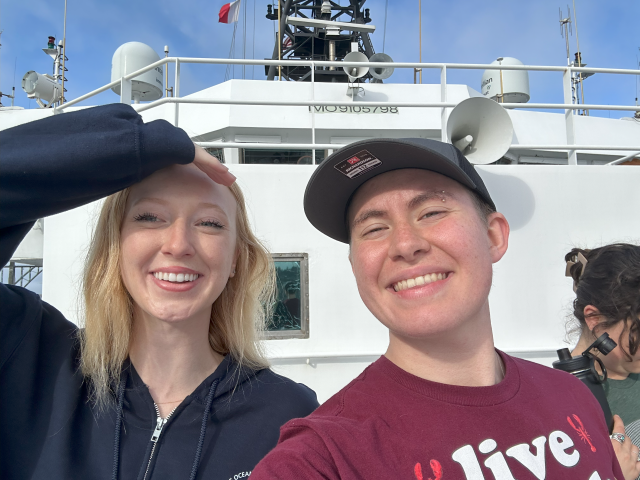 Morrigan (R) and team member onboard R/V Atlantis (Leg 2)[/caption]
[caption id="attachment_35517" align="alignnone" width="640"]
Morrigan (R) and team member onboard R/V Atlantis (Leg 2)[/caption]
[caption id="attachment_35517" align="alignnone" width="640"] Teammates interact during VISIONS 24 cruise.[/caption]
Read More
Teammates interact during VISIONS 24 cruise.[/caption]
Read More 
